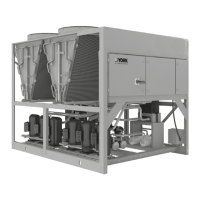JOHNSON CONTROLS
156
FORM 150.72-ICOM7
ISSUE DATE: 10/22/2020
SECTION 8 – UNIT OPERATION
SUCTION PRESSURE LIMIT CONTROLS
The anticipatory controls are intended to prevent the
unit from ever actually reaching a low-pressure cut-
out. Loading is prevented, if the suction pressure drops
below 1.15 x suction pressure cutout (15% below the
cutout). Loading may reoccur after suction pressure
rises above the unload point and a period of one min-
ute elapses. This control is only operable if the optional
suction pressure transducers are installed.
DISCHARGE PRESSURE LIMIT CONTROLS
The discharge pressure limit controls unload a system
before it reaches a safety limit due to high load or dirty
condenser coils. The microprocessor monitors dis-
charge pressure and unloads a system, if fully loaded,
by one compressor when discharge pressure exceeds
the programmed cutout minus 10 psig (0.69 barg). Re-
loading will occur when the discharge pressure on the
affected system drops to 85% of the unload pressure
and 10 min have elapsed.
This control is only applicable if optional discharge
pressure transducers are installed.
LEAVING CHILLED LIQUID CONTROL
The set point, when programmed for Leaving Chilled
Liquid Control, is the temperature the unit will control
to within plus or minus the (control) cooling range. The
Set Point High Limit is the Set Point plus the Cool-
ing Range. The Set Point Low Limit is the Set Point
minus the Cooling Range. Use the following figure to
understand the description of the Leaving Chilled Liq-
uid Control.
FIGURE 34 - LEAVING WATER TEMPERATURE
CONTROL EXAMPLE
44.0 ºF
(6.7 ºC)
Low Limit
46.0 ºF
(7.8 ºC)
Setpoint
48.0 ºF
(8.9 ºC)
High Limit
Leaving Water Temp. Control - Compressor Staging
Setpoint = 46.0 ºF (7.8 ºC) Range = +/-2 ºF (1.1 ºC)
30 sec.
unloading
60 sec.
loading
Contol Range
(no compressor staging)
LWT
LD14404
If the leaving chilled liquid temperature is above the
Set Point High Limit, the lead compressor on the lead
system will be energized along with the liquid line so-
lenoid. Upon energizing any compressor, the 60 s Anti-
Coincidence timer will be initiated to prevent multiple
compressors from turning ON.
If after 60 s of run-time the leaving chilled liquid tem-
perature is still above the Set Point High Limit, the next
compressor in sequence will be energized. Additional
compressors will be energized at a rate of once every
60 s if the chilled liquid temperature remains above the
Set Point High Limit and the chilled liquid temperature
is dropping less than 3 °F/min. The lag system will not
be allowed to start a compressor until the lead system
has run for 5 min.
If the chilled liquid temperature falls below the Set
Point High Limit but is greater than the Set Point Low
Limit, loading and unloading do not occur. This area of
control is called the control range.
If the chilled liquid temperature drops to between Set
Point Low Limit and 0.5°F (0.28°C) below the Set
Point Low Limit, unloading (a compressor turns OFF)
occurs at a rate of 1 every 30 s. If the chilled liquid
temperature falls to a value greater than 0.5°F (0.28°C)
below the Set Point Low Limit but not greater than
1.5°F (0.83°C) below the Set Point Low Limit, unload-
ing occurs at a rate of 20 s. If the chilled liquid temper-
ature falls to a value greater than 1.5°F (0.83°C) below
the Set Point Low Limit, unloading occurs at a rate of
10 s. If the chilled liquid temperature falls below 1°F
above the low chilled liquid temperature cutout, un-
loading occurs at a rate of 10 s if it is greater than 10 s.
In water cooling mode on R-410A chillers, the mini-
mum low limit of the control range will be 40.0ºF. For
leaving chilled liquid temperature set point and control
range combinations that result in the low limit of the
control range being below 40.0ºF, the low limit will be
reset to 40.0ºF and the difference will be added to the
high limit. This will result in a control range the same
size as programmed but not allow the unit to run below
40.0ºF. This control will not affect glycol chillers.
Hot gas, if present, will be the final step of capacity. Hot
gas is energized when only a single compressor is run-
ning and LWT is less than SP. Hot gas is turned OFF
as temperature rises when LWT is more than SP plus
CR/2. If temperature remains below the set point low
limit on the lowest step of capacity, the microprocessor
will close the liquid line solenoid, after turning off hot
gas, and pump the system down before turning off the
last compressor in a system.

